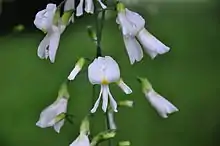Cladrastis
Cladrastis (yellowwood) is a genus of nine species of flowering plants in the family Fabaceae, eight native to eastern Asia, and one to southeastern North America.
| Cladrastis | |
|---|---|
 | |
| Cladrastis kentukea | |
| Scientific classification | |
| Kingdom: | Plantae |
| Clade: | Tracheophytes |
| Clade: | Angiosperms |
| Clade: | Eudicots |
| Clade: | Rosids |
| Order: | Fabales |
| Family: | Fabaceae |
| Subfamily: | Faboideae |
| Clade: | Cladrastis clade |
| Genus: | Cladrastis Raf. |
| Species | |
|
See text. | |
| Synonyms | |
| |
Species of Cladrastis are small to medium-sized deciduous trees typically growing 10–20 m tall, exceptionally to 27 m tall. The leaves are compound pinnate, with 5–17 alternately arranged leaflets. The flowers are fragrant, white or pink, produced in racemes or panicles 15–40 cm long. The fruit is a pod 3–8 cm long, containing one to six seeds.
Cladrastis is related to the genus Maackia, from which it differs in having the buds concealed in the leaf base, and in the leaflets being arranged alternately on the leaf rachis, not in opposite pairs. The genus name derives from the Greek klados, branch, and thraustos, fragile, referring to the brittle nature of the twigs. The combination of Cladrastis, Pickeringia and Styphnolobium form a monophyletic clade known as the Cladrastis clade; as the other two originated from within Cladrastis, Cladrastis is paraphyletic.[1][2][3]
Species
Cladrastis comprises the following species:[4][5]
- Cladrastis chingii Duley & Vincent
- Cladrastis delavayi (Franch.) Prain[6]
- Cladrastis kentukea (Dum. Cours.) Rudd—Southeastern North America.
- Cladrastis parvifolia C.Y. Ma—Guanxi, China.
- Cladrastis platycarpa (Maxim.) Makino—Japan.
- Cladrastis scandens C.Y. Ma—Guizhou, China.
- Cladrastis shikokiana (Makino) Makino—Southern Japan.
- Cladrastis sinensis Hemsl.—China, widespread.
- Cladrastis wilsonii Takeda—Central China.
References
- Cardoso D, Pennington RT, de Queiroz LP, Boatwright JS, Van Wyk BE, Wojciechowski MF, Lavin M (2013). "Reconstructing the deep-branching relationships of the papilionoid legumes". S Afr J Bot. 89: 58–75. doi:10.1016/j.sajb.2013.05.001.
- Cardoso D, de Queiroz LP, Pennington RT, de Lima HC, Fonty É, Wojciechowski MF, Lavin M (2012). "Revisiting the phylogeny of papilionoid legumes: new insights from comprehensively sampled early-branching lineages". Am J Bot. 99 (12): 1991–2013. doi:10.3732/ajb.1200380. PMID 23221500.
- Wojciechowski MF (2013). "The origin and phylogenetic relationships of the Californian chaparral 'paleoendemic' Pickeringia (Leguminosae)". Syst Bot. 38 (1): 132–142. doi:10.1600/036364413X662024.
- "ILDIS LegumeWeb entry for Cladrastis". International Legume Database & Information Service. Cardiff School of Computer Science & Informatics. Retrieved 12 February 2014.
- USDA; ARS; National Genetic Resources Program. "GRIN species records of Cladrastis". Germplasm Resources Information Network—(GRIN) [Online Database]. National Germplasm Resources Laboratory, Beltsville, Maryland. Archived from the original on 24 September 2015. Retrieved 12 February 2014.
- Some sources treat Cladrastis delavayi as a synonym of Cladrastis sinensis.
Further reading
- Andrews S (1997). "Trees of the Year: Cladrastis and Maakia". Int. Dendrol. Soc. Year Book. 1996: 12–26.
- Spongberg SA, Ma JS (1997). "Cladrastis (Leguminosae subfamily Faboideae tribe Sophoreae): a historic and taxonomic overview". Int. Dendrol. Soc. Year Book. 1996: 27–35.
| Wikispecies has information related to Cladrastis. |
| Wikimedia Commons has media related to Cladrastis. |